Demand, Supply, and Price Elasticity: Strategic Management Essay
VerifiedAdded on 2023/05/30
|22
|5373
|370
Essay
AI Summary
This essay provides a comprehensive analysis of price elasticity of demand within the context of strategic management. It begins with an introduction to microeconomics, focusing on demand and supply analysis as fundamental concepts. The essay defines price elasticity of demand, categorizing it into elastic, unitary, and inelastic types, and explains how these classifications relate to the responsiveness of demand to price changes. It further explores the factors that influence price elasticity, including the nature of the product, availability of substitutes, quantity and variety of uses, percentage of income spent, consumer habits, deferment possibilities, and the product's price itself. Each factor's impact on demand is discussed in detail, providing a thorough understanding of how businesses can leverage these concepts in strategic decision-making. The essay concludes by emphasizing the importance of understanding demand and supply dynamics for achieving market equilibrium and financial stability.
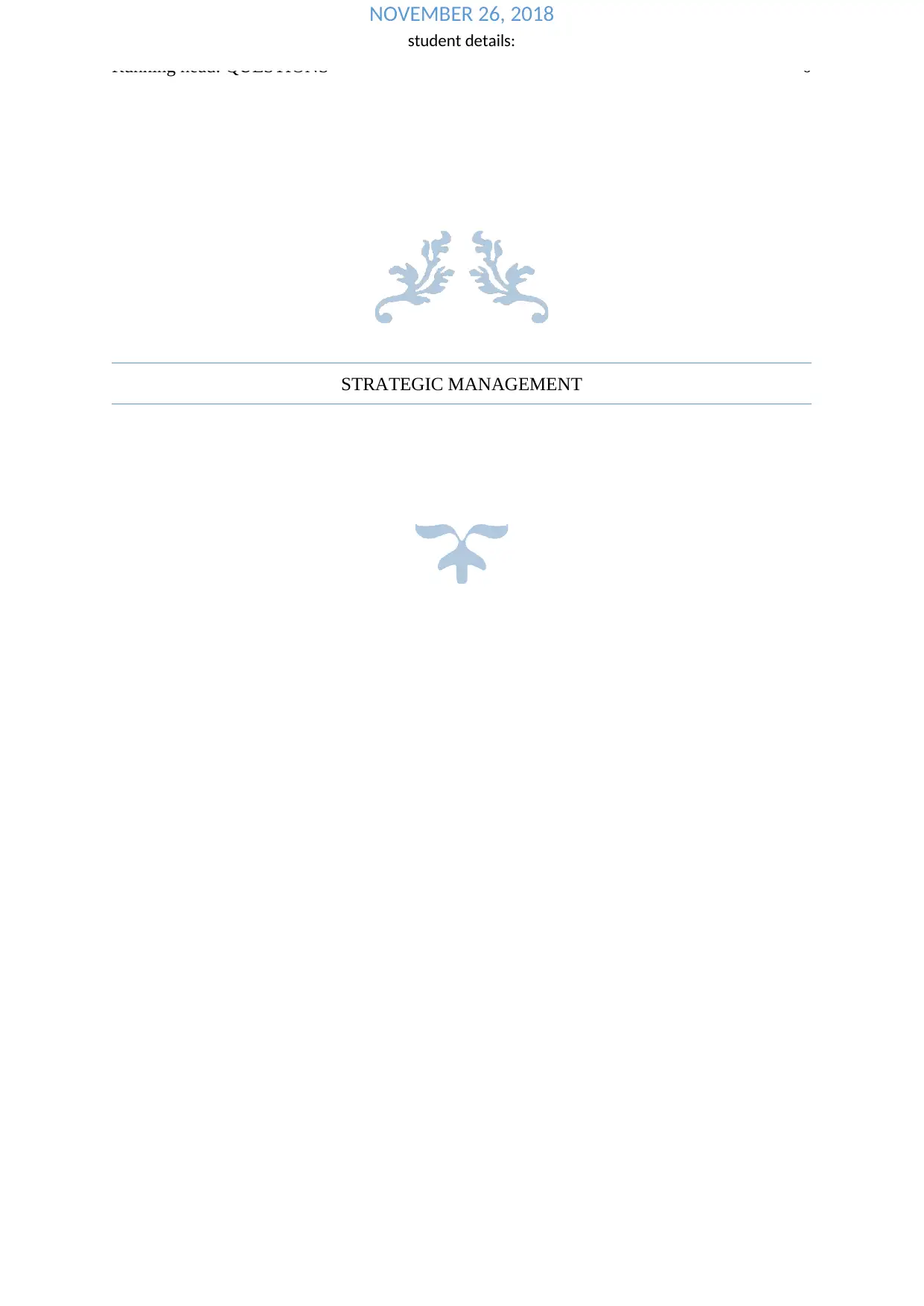
Running head: QUESTIONS 0
STRATEGIC MANAGEMENT
NOVEMBER 26, 2018
student details:
STRATEGIC MANAGEMENT
NOVEMBER 26, 2018
student details:
Paraphrase This Document
Need a fresh take? Get an instant paraphrase of this document with our AI Paraphraser
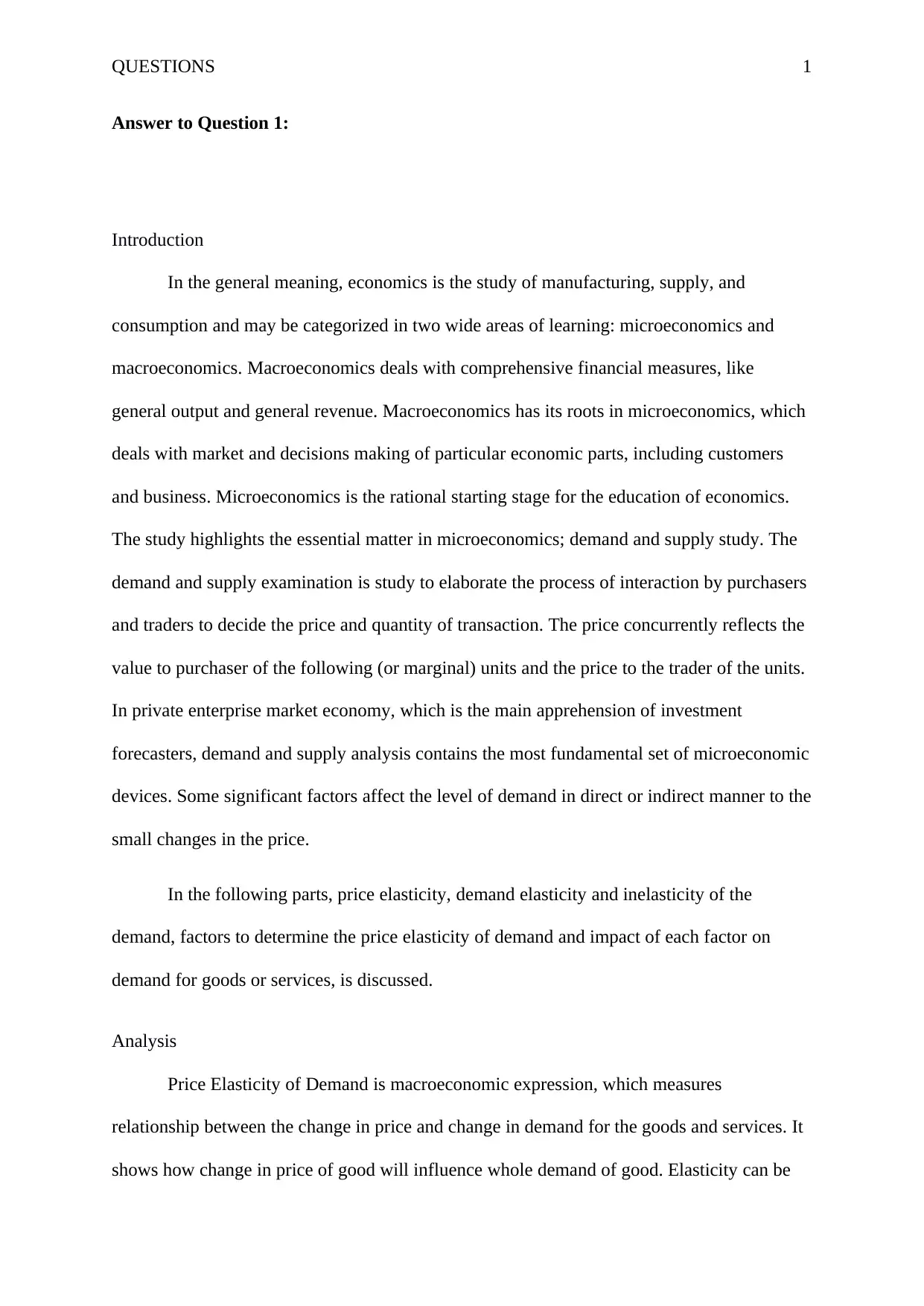
QUESTIONS 1
Answer to Question 1:
Introduction
In the general meaning, economics is the study of manufacturing, supply, and
consumption and may be categorized in two wide areas of learning: microeconomics and
macroeconomics. Macroeconomics deals with comprehensive financial measures, like
general output and general revenue. Macroeconomics has its roots in microeconomics, which
deals with market and decisions making of particular economic parts, including customers
and business. Microeconomics is the rational starting stage for the education of economics.
The study highlights the essential matter in microeconomics; demand and supply study. The
demand and supply examination is study to elaborate the process of interaction by purchasers
and traders to decide the price and quantity of transaction. The price concurrently reflects the
value to purchaser of the following (or marginal) units and the price to the trader of the units.
In private enterprise market economy, which is the main apprehension of investment
forecasters, demand and supply analysis contains the most fundamental set of microeconomic
devices. Some significant factors affect the level of demand in direct or indirect manner to the
small changes in the price.
In the following parts, price elasticity, demand elasticity and inelasticity of the
demand, factors to determine the price elasticity of demand and impact of each factor on
demand for goods or services, is discussed.
Analysis
Price Elasticity of Demand is macroeconomic expression, which measures
relationship between the change in price and change in demand for the goods and services. It
shows how change in price of good will influence whole demand of good. Elasticity can be
Answer to Question 1:
Introduction
In the general meaning, economics is the study of manufacturing, supply, and
consumption and may be categorized in two wide areas of learning: microeconomics and
macroeconomics. Macroeconomics deals with comprehensive financial measures, like
general output and general revenue. Macroeconomics has its roots in microeconomics, which
deals with market and decisions making of particular economic parts, including customers
and business. Microeconomics is the rational starting stage for the education of economics.
The study highlights the essential matter in microeconomics; demand and supply study. The
demand and supply examination is study to elaborate the process of interaction by purchasers
and traders to decide the price and quantity of transaction. The price concurrently reflects the
value to purchaser of the following (or marginal) units and the price to the trader of the units.
In private enterprise market economy, which is the main apprehension of investment
forecasters, demand and supply analysis contains the most fundamental set of microeconomic
devices. Some significant factors affect the level of demand in direct or indirect manner to the
small changes in the price.
In the following parts, price elasticity, demand elasticity and inelasticity of the
demand, factors to determine the price elasticity of demand and impact of each factor on
demand for goods or services, is discussed.
Analysis
Price Elasticity of Demand is macroeconomic expression, which measures
relationship between the change in price and change in demand for the goods and services. It
shows how change in price of good will influence whole demand of good. Elasticity can be
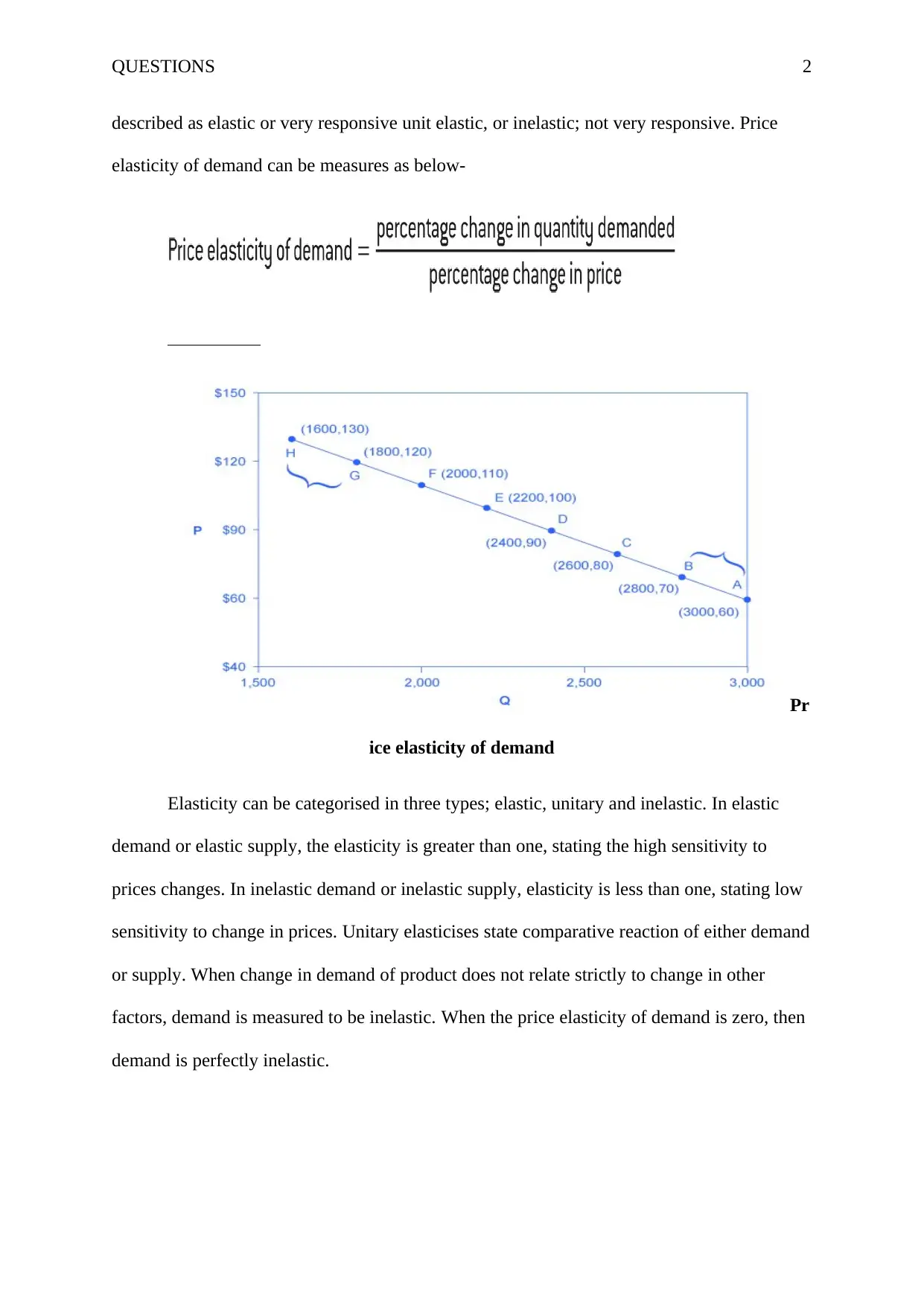
QUESTIONS 2
described as elastic or very responsive unit elastic, or inelastic; not very responsive. Price
elasticity of demand can be measures as below-
Pr
ice elasticity of demand
Elasticity can be categorised in three types; elastic, unitary and inelastic. In elastic
demand or elastic supply, the elasticity is greater than one, stating the high sensitivity to
prices changes. In inelastic demand or inelastic supply, elasticity is less than one, stating low
sensitivity to change in prices. Unitary elasticises state comparative reaction of either demand
or supply. When change in demand of product does not relate strictly to change in other
factors, demand is measured to be inelastic. When the price elasticity of demand is zero, then
demand is perfectly inelastic.
described as elastic or very responsive unit elastic, or inelastic; not very responsive. Price
elasticity of demand can be measures as below-
Pr
ice elasticity of demand
Elasticity can be categorised in three types; elastic, unitary and inelastic. In elastic
demand or elastic supply, the elasticity is greater than one, stating the high sensitivity to
prices changes. In inelastic demand or inelastic supply, elasticity is less than one, stating low
sensitivity to change in prices. Unitary elasticises state comparative reaction of either demand
or supply. When change in demand of product does not relate strictly to change in other
factors, demand is measured to be inelastic. When the price elasticity of demand is zero, then
demand is perfectly inelastic.
⊘ This is a preview!⊘
Do you want full access?
Subscribe today to unlock all pages.

Trusted by 1+ million students worldwide
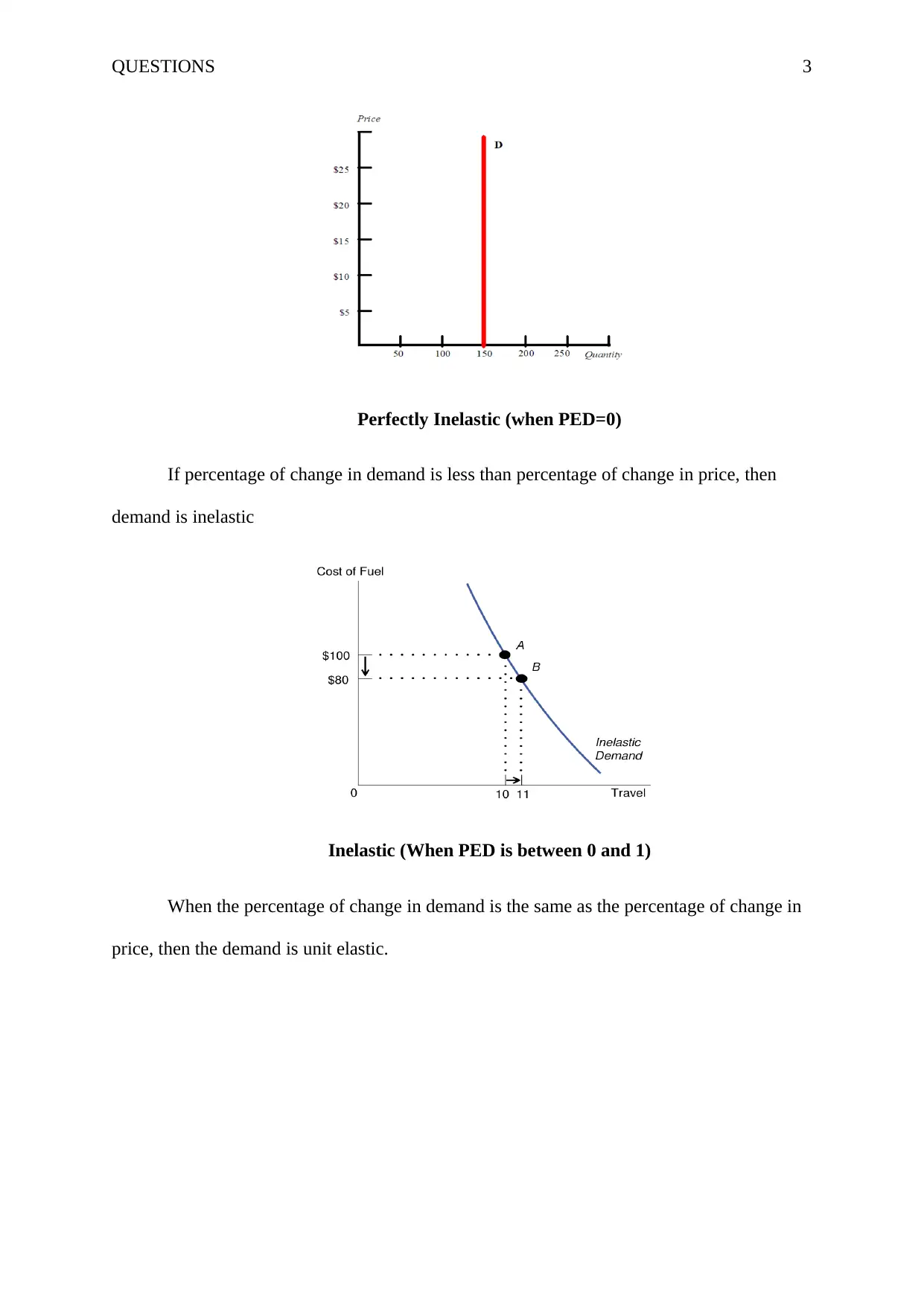
QUESTIONS 3
Perfectly Inelastic (when PED=0)
If percentage of change in demand is less than percentage of change in price, then
demand is inelastic
Inelastic (When PED is between 0 and 1)
When the percentage of change in demand is the same as the percentage of change in
price, then the demand is unit elastic.
Perfectly Inelastic (when PED=0)
If percentage of change in demand is less than percentage of change in price, then
demand is inelastic
Inelastic (When PED is between 0 and 1)
When the percentage of change in demand is the same as the percentage of change in
price, then the demand is unit elastic.
Paraphrase This Document
Need a fresh take? Get an instant paraphrase of this document with our AI Paraphraser
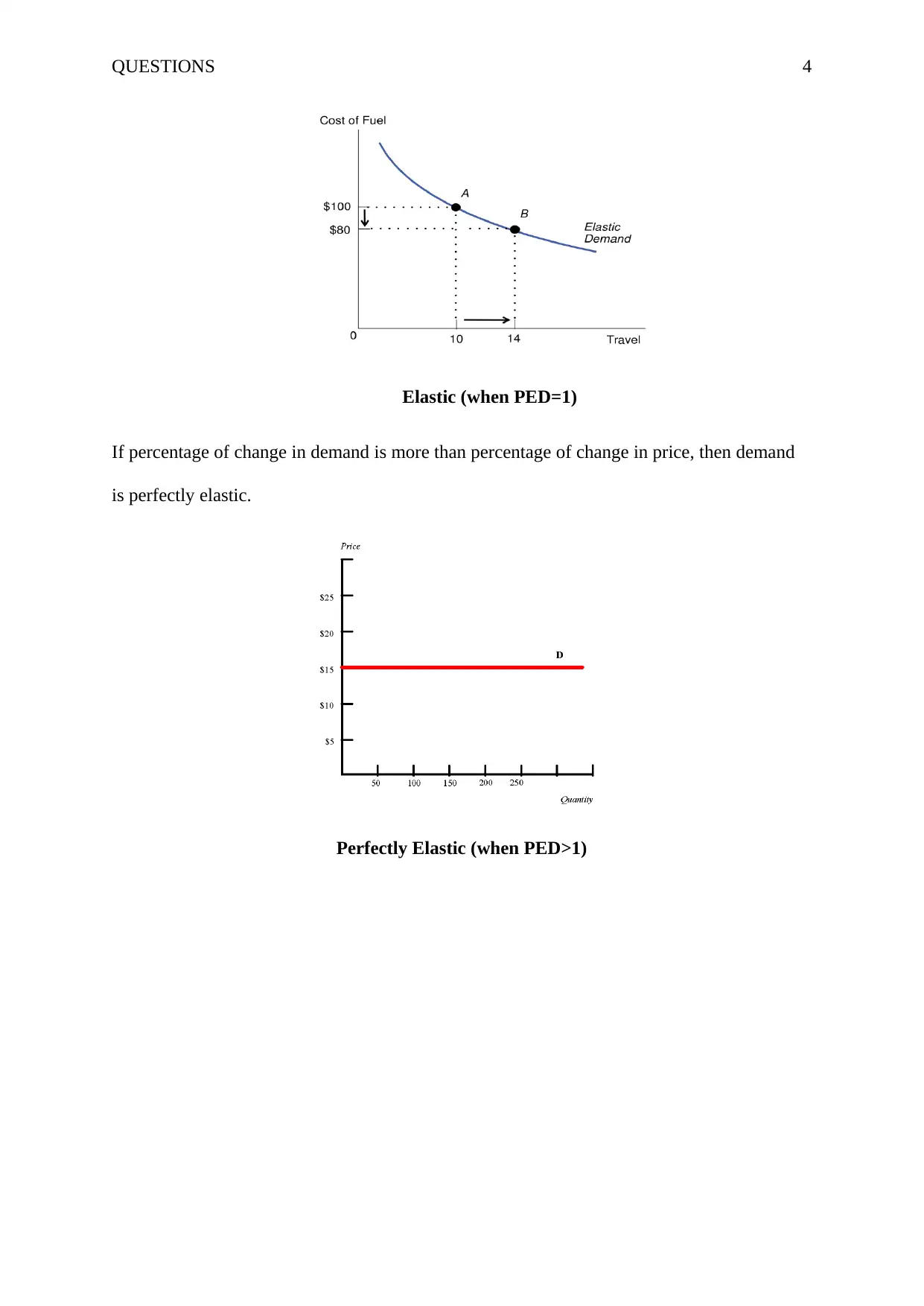
QUESTIONS 4
Elastic (when PED=1)
If percentage of change in demand is more than percentage of change in price, then demand
is perfectly elastic.
Perfectly Elastic (when PED>1)
Elastic (when PED=1)
If percentage of change in demand is more than percentage of change in price, then demand
is perfectly elastic.
Perfectly Elastic (when PED>1)
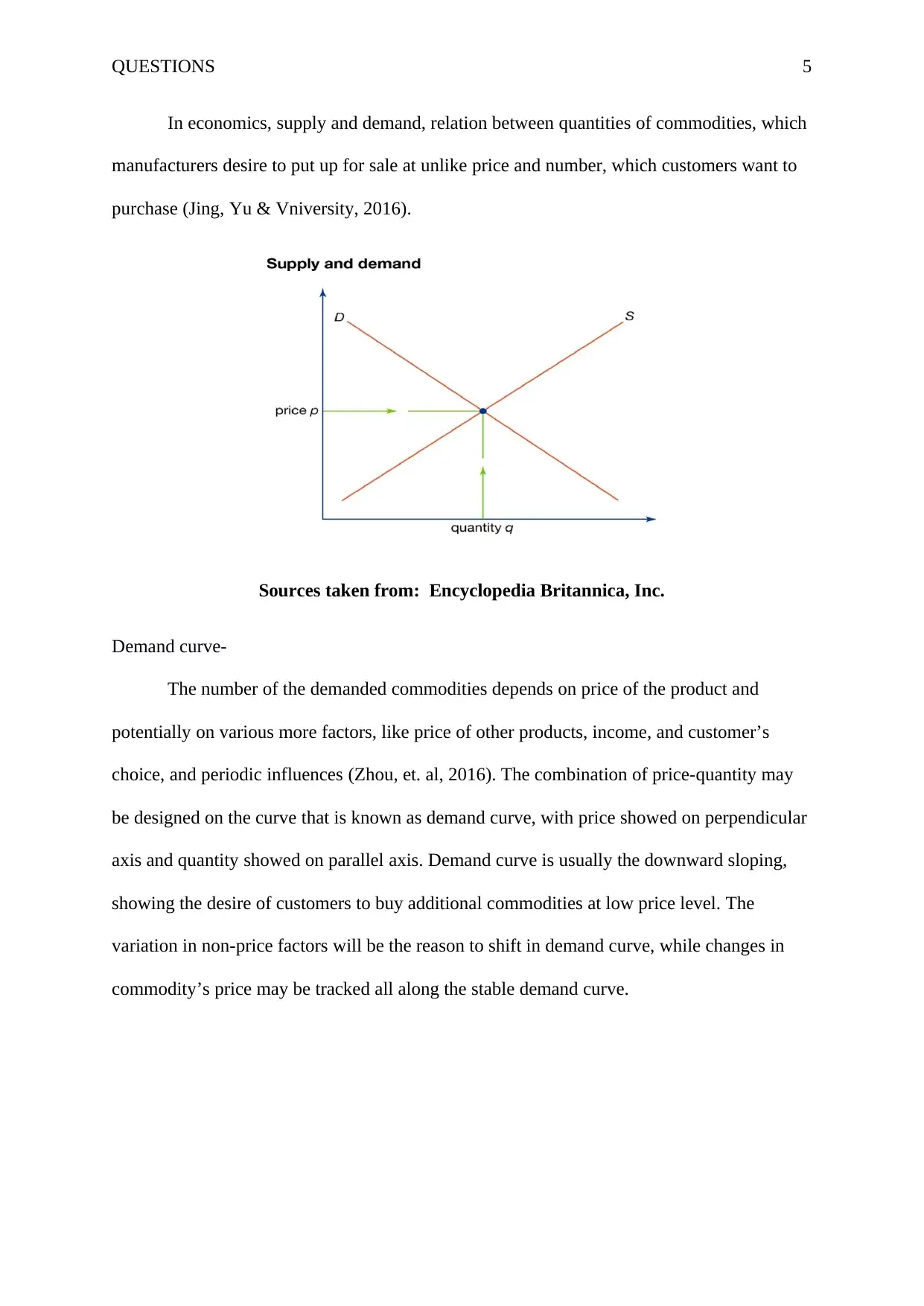
QUESTIONS 5
In economics, supply and demand, relation between quantities of commodities, which
manufacturers desire to put up for sale at unlike price and number, which customers want to
purchase (Jing, Yu & Vniversity, 2016).
Sources taken from: Encyclopedia Britannica, Inc.
Demand curve-
The number of the demanded commodities depends on price of the product and
potentially on various more factors, like price of other products, income, and customer’s
choice, and periodic influences (Zhou, et. al, 2016). The combination of price-quantity may
be designed on the curve that is known as demand curve, with price showed on perpendicular
axis and quantity showed on parallel axis. Demand curve is usually the downward sloping,
showing the desire of customers to buy additional commodities at low price level. The
variation in non-price factors will be the reason to shift in demand curve, while changes in
commodity’s price may be tracked all along the stable demand curve.
In economics, supply and demand, relation between quantities of commodities, which
manufacturers desire to put up for sale at unlike price and number, which customers want to
purchase (Jing, Yu & Vniversity, 2016).
Sources taken from: Encyclopedia Britannica, Inc.
Demand curve-
The number of the demanded commodities depends on price of the product and
potentially on various more factors, like price of other products, income, and customer’s
choice, and periodic influences (Zhou, et. al, 2016). The combination of price-quantity may
be designed on the curve that is known as demand curve, with price showed on perpendicular
axis and quantity showed on parallel axis. Demand curve is usually the downward sloping,
showing the desire of customers to buy additional commodities at low price level. The
variation in non-price factors will be the reason to shift in demand curve, while changes in
commodity’s price may be tracked all along the stable demand curve.
⊘ This is a preview!⊘
Do you want full access?
Subscribe today to unlock all pages.

Trusted by 1+ million students worldwide
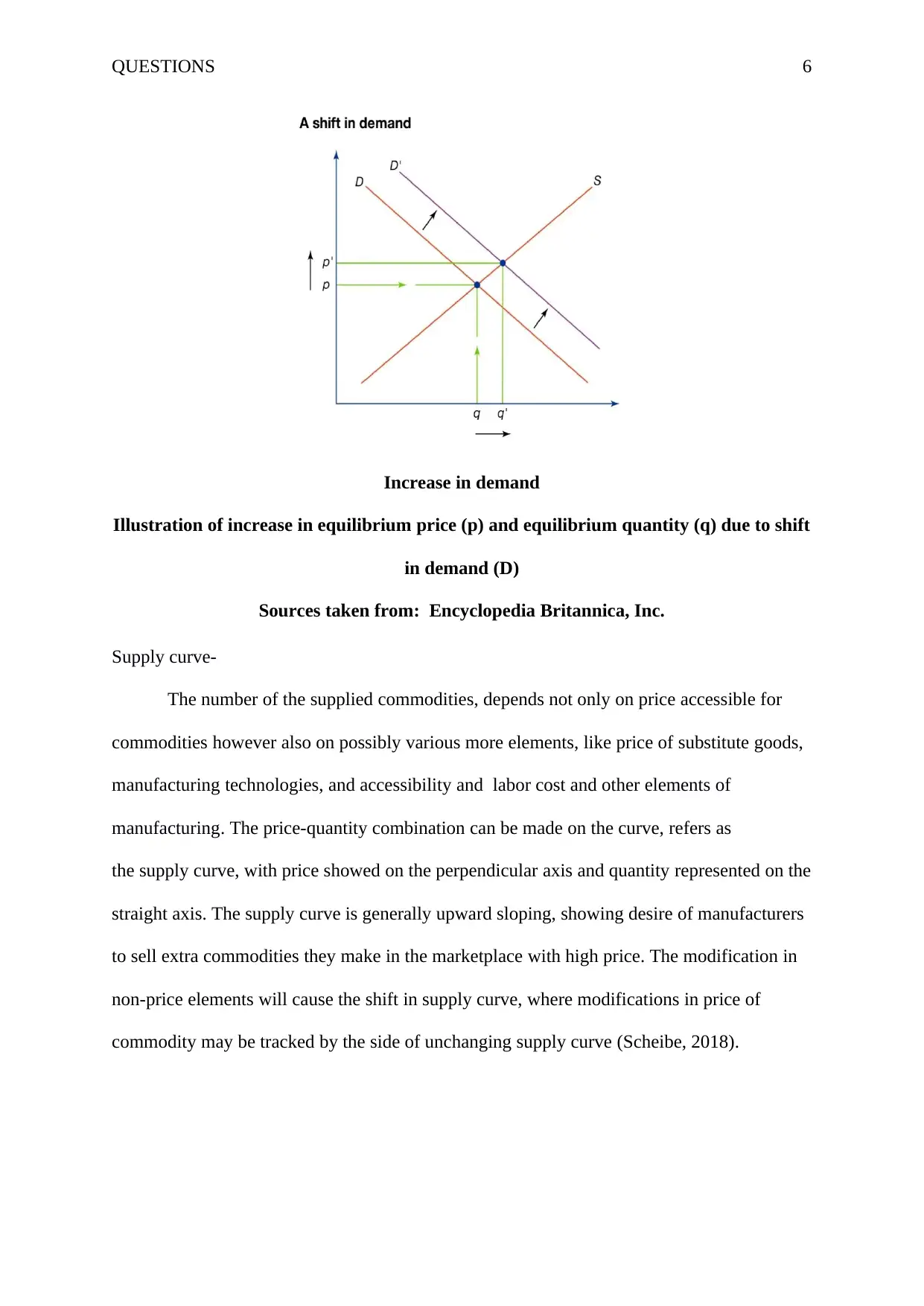
QUESTIONS 6
Increase in demand
Illustration of increase in equilibrium price (p) and equilibrium quantity (q) due to shift
in demand (D)
Sources taken from: Encyclopedia Britannica, Inc.
Supply curve-
The number of the supplied commodities, depends not only on price accessible for
commodities however also on possibly various more elements, like price of substitute goods,
manufacturing technologies, and accessibility and labor cost and other elements of
manufacturing. The price-quantity combination can be made on the curve, refers as
the supply curve, with price showed on the perpendicular axis and quantity represented on the
straight axis. The supply curve is generally upward sloping, showing desire of manufacturers
to sell extra commodities they make in the marketplace with high price. The modification in
non-price elements will cause the shift in supply curve, where modifications in price of
commodity may be tracked by the side of unchanging supply curve (Scheibe, 2018).
Increase in demand
Illustration of increase in equilibrium price (p) and equilibrium quantity (q) due to shift
in demand (D)
Sources taken from: Encyclopedia Britannica, Inc.
Supply curve-
The number of the supplied commodities, depends not only on price accessible for
commodities however also on possibly various more elements, like price of substitute goods,
manufacturing technologies, and accessibility and labor cost and other elements of
manufacturing. The price-quantity combination can be made on the curve, refers as
the supply curve, with price showed on the perpendicular axis and quantity represented on the
straight axis. The supply curve is generally upward sloping, showing desire of manufacturers
to sell extra commodities they make in the marketplace with high price. The modification in
non-price elements will cause the shift in supply curve, where modifications in price of
commodity may be tracked by the side of unchanging supply curve (Scheibe, 2018).
Paraphrase This Document
Need a fresh take? Get an instant paraphrase of this document with our AI Paraphraser
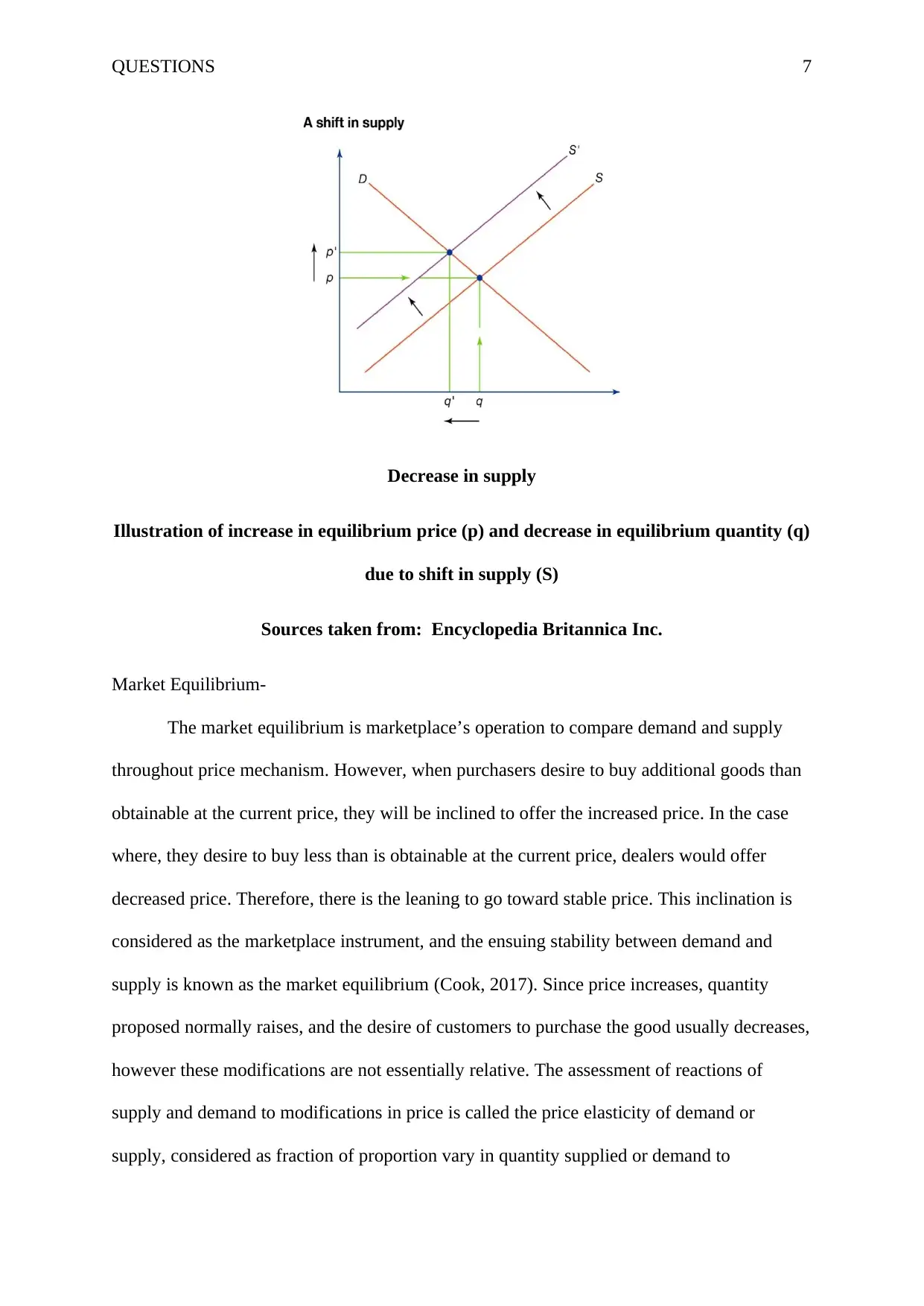
QUESTIONS 7
Decrease in supply
Illustration of increase in equilibrium price (p) and decrease in equilibrium quantity (q)
due to shift in supply (S)
Sources taken from: Encyclopedia Britannica Inc.
Market Equilibrium-
The market equilibrium is marketplace’s operation to compare demand and supply
throughout price mechanism. However, when purchasers desire to buy additional goods than
obtainable at the current price, they will be inclined to offer the increased price. In the case
where, they desire to buy less than is obtainable at the current price, dealers would offer
decreased price. Therefore, there is the leaning to go toward stable price. This inclination is
considered as the marketplace instrument, and the ensuing stability between demand and
supply is known as the market equilibrium (Cook, 2017). Since price increases, quantity
proposed normally raises, and the desire of customers to purchase the good usually decreases,
however these modifications are not essentially relative. The assessment of reactions of
supply and demand to modifications in price is called the price elasticity of demand or
supply, considered as fraction of proportion vary in quantity supplied or demand to
Decrease in supply
Illustration of increase in equilibrium price (p) and decrease in equilibrium quantity (q)
due to shift in supply (S)
Sources taken from: Encyclopedia Britannica Inc.
Market Equilibrium-
The market equilibrium is marketplace’s operation to compare demand and supply
throughout price mechanism. However, when purchasers desire to buy additional goods than
obtainable at the current price, they will be inclined to offer the increased price. In the case
where, they desire to buy less than is obtainable at the current price, dealers would offer
decreased price. Therefore, there is the leaning to go toward stable price. This inclination is
considered as the marketplace instrument, and the ensuing stability between demand and
supply is known as the market equilibrium (Cook, 2017). Since price increases, quantity
proposed normally raises, and the desire of customers to purchase the good usually decreases,
however these modifications are not essentially relative. The assessment of reactions of
supply and demand to modifications in price is called the price elasticity of demand or
supply, considered as fraction of proportion vary in quantity supplied or demand to
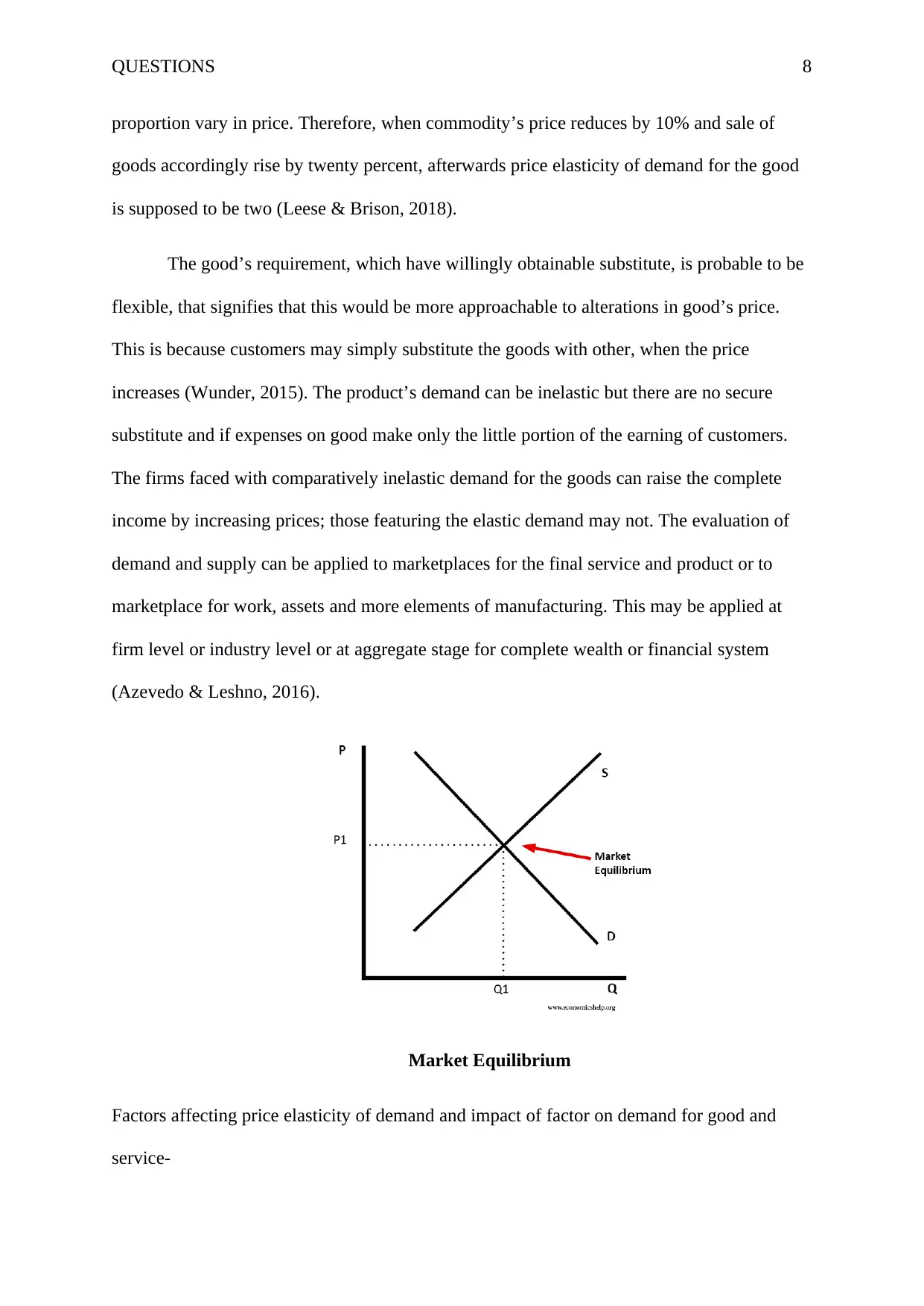
QUESTIONS 8
proportion vary in price. Therefore, when commodity’s price reduces by 10% and sale of
goods accordingly rise by twenty percent, afterwards price elasticity of demand for the good
is supposed to be two (Leese & Brison, 2018).
The good’s requirement, which have willingly obtainable substitute, is probable to be
flexible, that signifies that this would be more approachable to alterations in good’s price.
This is because customers may simply substitute the goods with other, when the price
increases (Wunder, 2015). The product’s demand can be inelastic but there are no secure
substitute and if expenses on good make only the little portion of the earning of customers.
The firms faced with comparatively inelastic demand for the goods can raise the complete
income by increasing prices; those featuring the elastic demand may not. The evaluation of
demand and supply can be applied to marketplaces for the final service and product or to
marketplace for work, assets and more elements of manufacturing. This may be applied at
firm level or industry level or at aggregate stage for complete wealth or financial system
(Azevedo & Leshno, 2016).
Market Equilibrium
Factors affecting price elasticity of demand and impact of factor on demand for good and
service-
proportion vary in price. Therefore, when commodity’s price reduces by 10% and sale of
goods accordingly rise by twenty percent, afterwards price elasticity of demand for the good
is supposed to be two (Leese & Brison, 2018).
The good’s requirement, which have willingly obtainable substitute, is probable to be
flexible, that signifies that this would be more approachable to alterations in good’s price.
This is because customers may simply substitute the goods with other, when the price
increases (Wunder, 2015). The product’s demand can be inelastic but there are no secure
substitute and if expenses on good make only the little portion of the earning of customers.
The firms faced with comparatively inelastic demand for the goods can raise the complete
income by increasing prices; those featuring the elastic demand may not. The evaluation of
demand and supply can be applied to marketplaces for the final service and product or to
marketplace for work, assets and more elements of manufacturing. This may be applied at
firm level or industry level or at aggregate stage for complete wealth or financial system
(Azevedo & Leshno, 2016).
Market Equilibrium
Factors affecting price elasticity of demand and impact of factor on demand for good and
service-
⊘ This is a preview!⊘
Do you want full access?
Subscribe today to unlock all pages.

Trusted by 1+ million students worldwide
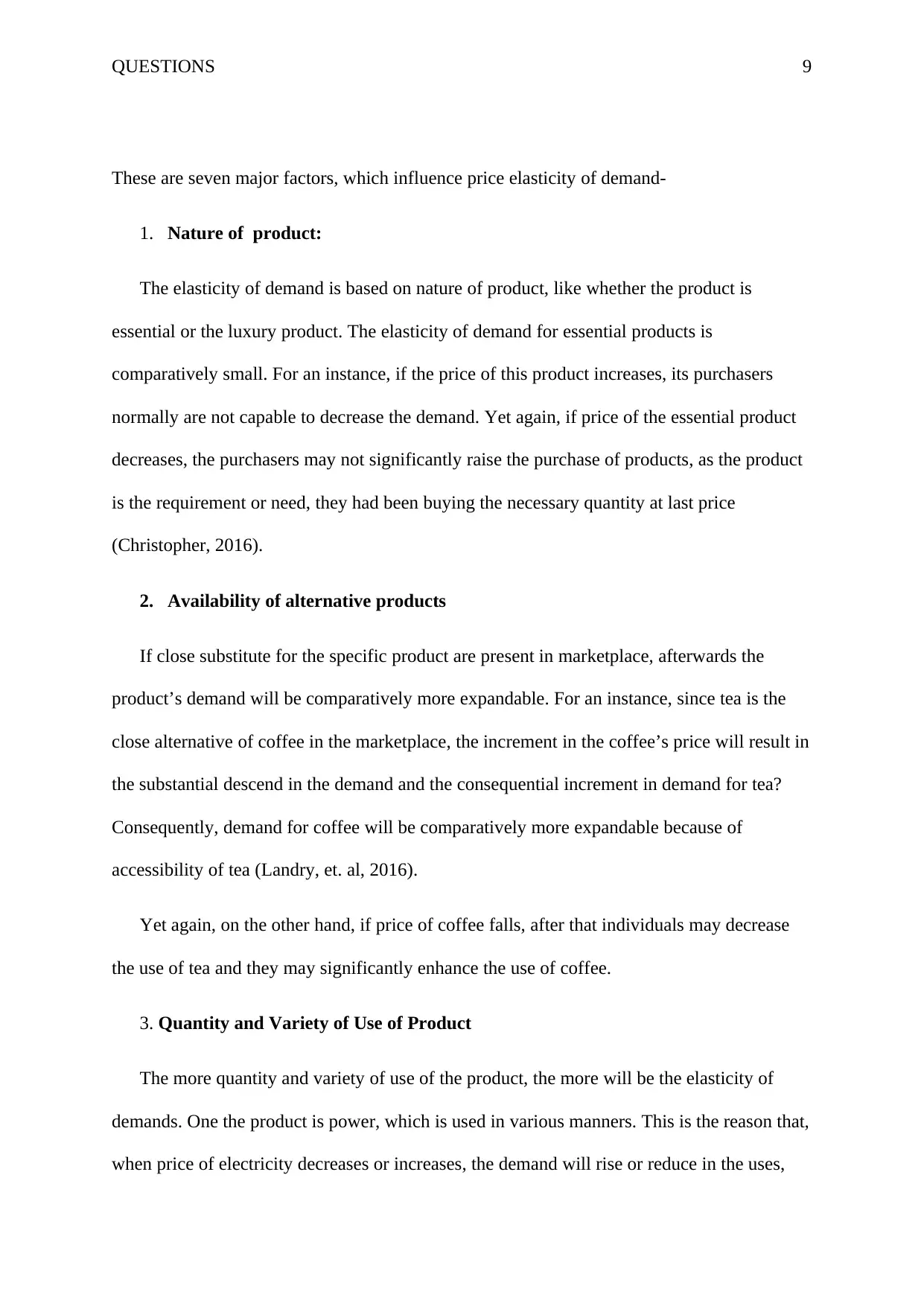
QUESTIONS 9
These are seven major factors, which influence price elasticity of demand-
1. Nature of product:
The elasticity of demand is based on nature of product, like whether the product is
essential or the luxury product. The elasticity of demand for essential products is
comparatively small. For an instance, if the price of this product increases, its purchasers
normally are not capable to decrease the demand. Yet again, if price of the essential product
decreases, the purchasers may not significantly raise the purchase of products, as the product
is the requirement or need, they had been buying the necessary quantity at last price
(Christopher, 2016).
2. Availability of alternative products
If close substitute for the specific product are present in marketplace, afterwards the
product’s demand will be comparatively more expandable. For an instance, since tea is the
close alternative of coffee in the marketplace, the increment in the coffee’s price will result in
the substantial descend in the demand and the consequential increment in demand for tea?
Consequently, demand for coffee will be comparatively more expandable because of
accessibility of tea (Landry, et. al, 2016).
Yet again, on the other hand, if price of coffee falls, after that individuals may decrease
the use of tea and they may significantly enhance the use of coffee.
3. Quantity and Variety of Use of Product
The more quantity and variety of use of the product, the more will be the elasticity of
demands. One the product is power, which is used in various manners. This is the reason that,
when price of electricity decreases or increases, the demand will rise or reduce in the uses,
These are seven major factors, which influence price elasticity of demand-
1. Nature of product:
The elasticity of demand is based on nature of product, like whether the product is
essential or the luxury product. The elasticity of demand for essential products is
comparatively small. For an instance, if the price of this product increases, its purchasers
normally are not capable to decrease the demand. Yet again, if price of the essential product
decreases, the purchasers may not significantly raise the purchase of products, as the product
is the requirement or need, they had been buying the necessary quantity at last price
(Christopher, 2016).
2. Availability of alternative products
If close substitute for the specific product are present in marketplace, afterwards the
product’s demand will be comparatively more expandable. For an instance, since tea is the
close alternative of coffee in the marketplace, the increment in the coffee’s price will result in
the substantial descend in the demand and the consequential increment in demand for tea?
Consequently, demand for coffee will be comparatively more expandable because of
accessibility of tea (Landry, et. al, 2016).
Yet again, on the other hand, if price of coffee falls, after that individuals may decrease
the use of tea and they may significantly enhance the use of coffee.
3. Quantity and Variety of Use of Product
The more quantity and variety of use of the product, the more will be the elasticity of
demands. One the product is power, which is used in various manners. This is the reason that,
when price of electricity decreases or increases, the demand will rise or reduce in the uses,
Paraphrase This Document
Need a fresh take? Get an instant paraphrase of this document with our AI Paraphraser
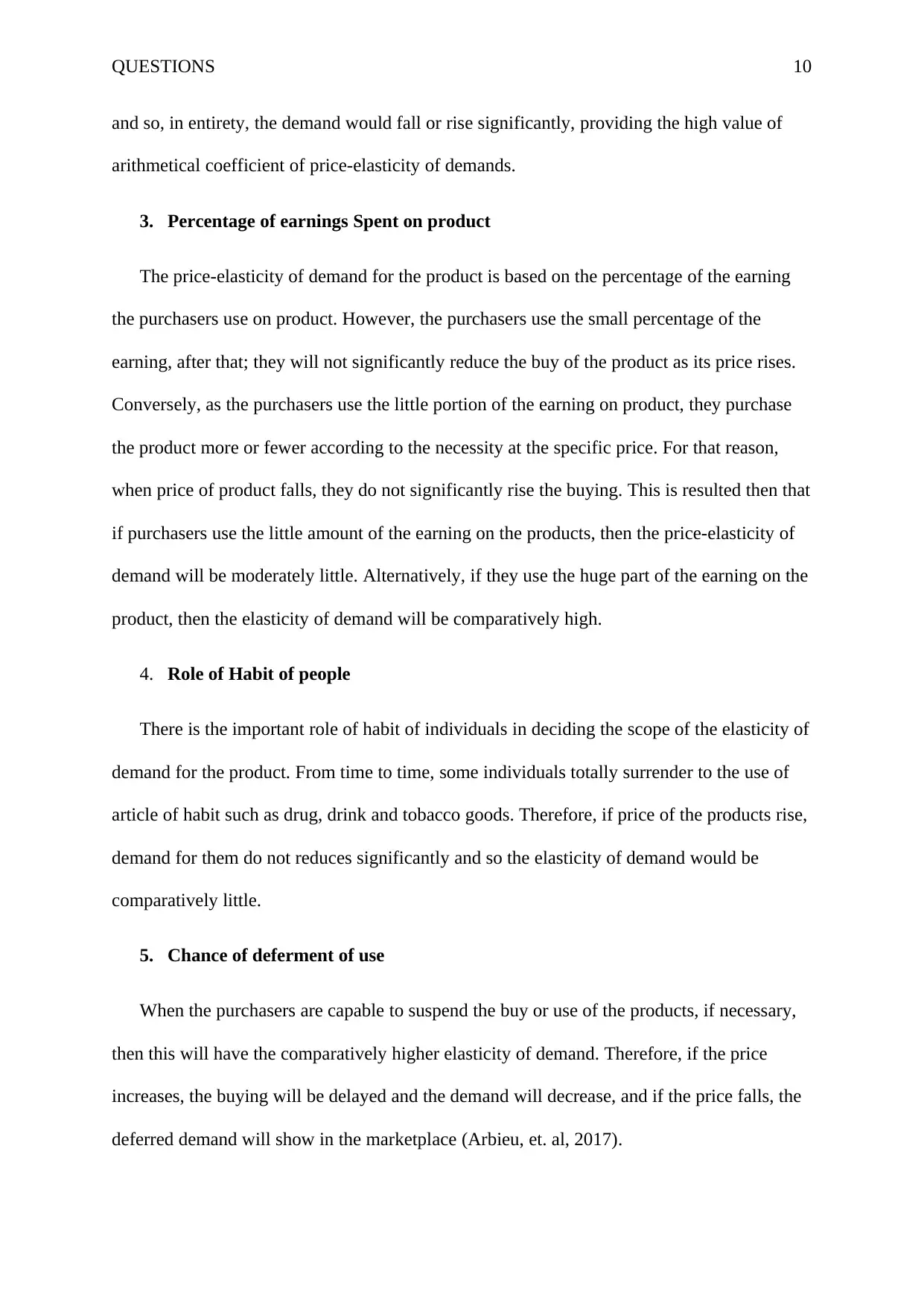
QUESTIONS 10
and so, in entirety, the demand would fall or rise significantly, providing the high value of
arithmetical coefficient of price-elasticity of demands.
3. Percentage of earnings Spent on product
The price-elasticity of demand for the product is based on the percentage of the earning
the purchasers use on product. However, the purchasers use the small percentage of the
earning, after that; they will not significantly reduce the buy of the product as its price rises.
Conversely, as the purchasers use the little portion of the earning on product, they purchase
the product more or fewer according to the necessity at the specific price. For that reason,
when price of product falls, they do not significantly rise the buying. This is resulted then that
if purchasers use the little amount of the earning on the products, then the price-elasticity of
demand will be moderately little. Alternatively, if they use the huge part of the earning on the
product, then the elasticity of demand will be comparatively high.
4. Role of Habit of people
There is the important role of habit of individuals in deciding the scope of the elasticity of
demand for the product. From time to time, some individuals totally surrender to the use of
article of habit such as drug, drink and tobacco goods. Therefore, if price of the products rise,
demand for them do not reduces significantly and so the elasticity of demand would be
comparatively little.
5. Chance of deferment of use
When the purchasers are capable to suspend the buy or use of the products, if necessary,
then this will have the comparatively higher elasticity of demand. Therefore, if the price
increases, the buying will be delayed and the demand will decrease, and if the price falls, the
deferred demand will show in the marketplace (Arbieu, et. al, 2017).
and so, in entirety, the demand would fall or rise significantly, providing the high value of
arithmetical coefficient of price-elasticity of demands.
3. Percentage of earnings Spent on product
The price-elasticity of demand for the product is based on the percentage of the earning
the purchasers use on product. However, the purchasers use the small percentage of the
earning, after that; they will not significantly reduce the buy of the product as its price rises.
Conversely, as the purchasers use the little portion of the earning on product, they purchase
the product more or fewer according to the necessity at the specific price. For that reason,
when price of product falls, they do not significantly rise the buying. This is resulted then that
if purchasers use the little amount of the earning on the products, then the price-elasticity of
demand will be moderately little. Alternatively, if they use the huge part of the earning on the
product, then the elasticity of demand will be comparatively high.
4. Role of Habit of people
There is the important role of habit of individuals in deciding the scope of the elasticity of
demand for the product. From time to time, some individuals totally surrender to the use of
article of habit such as drug, drink and tobacco goods. Therefore, if price of the products rise,
demand for them do not reduces significantly and so the elasticity of demand would be
comparatively little.
5. Chance of deferment of use
When the purchasers are capable to suspend the buy or use of the products, if necessary,
then this will have the comparatively higher elasticity of demand. Therefore, if the price
increases, the buying will be delayed and the demand will decrease, and if the price falls, the
deferred demand will show in the marketplace (Arbieu, et. al, 2017).
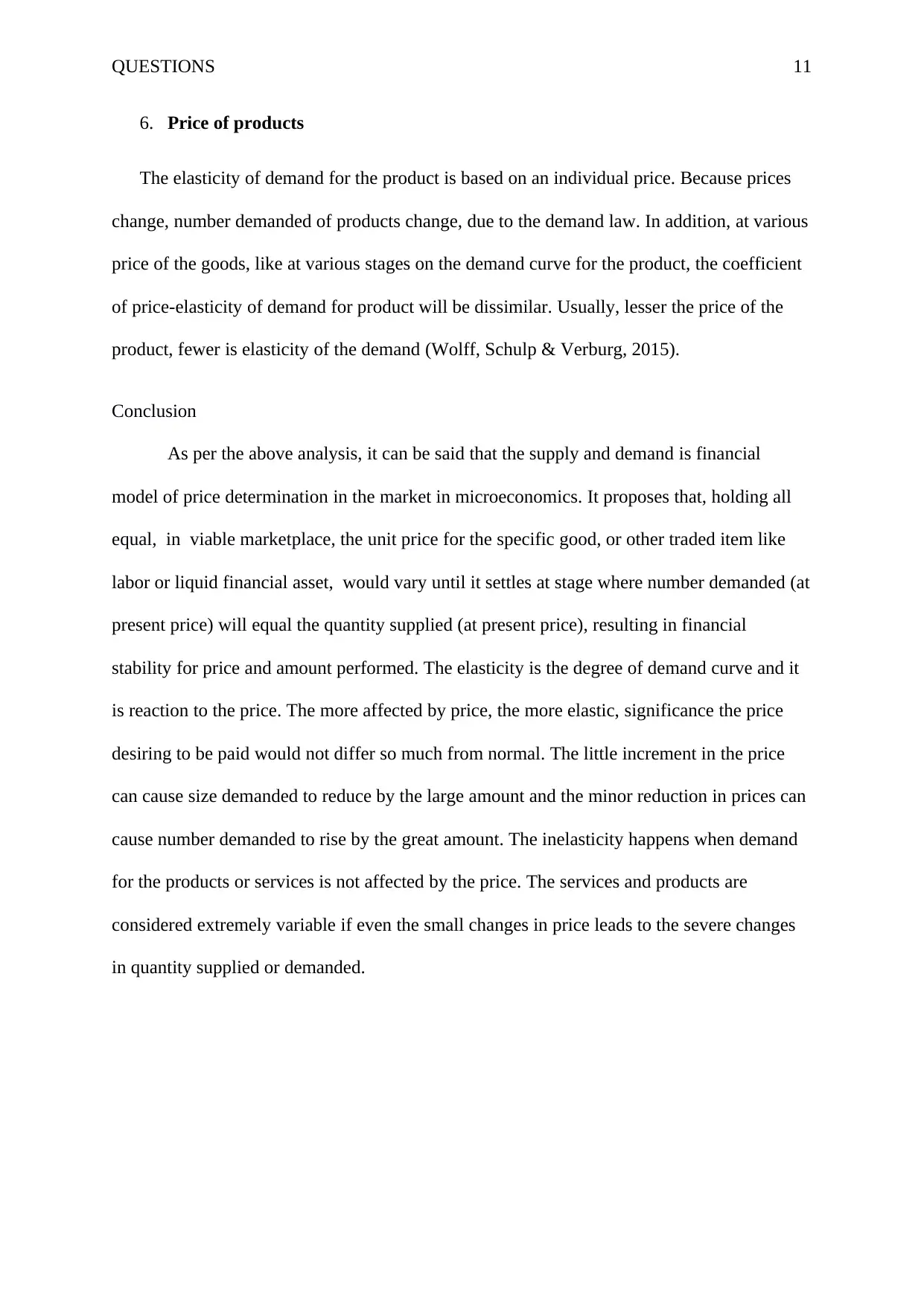
QUESTIONS 11
6. Price of products
The elasticity of demand for the product is based on an individual price. Because prices
change, number demanded of products change, due to the demand law. In addition, at various
price of the goods, like at various stages on the demand curve for the product, the coefficient
of price-elasticity of demand for product will be dissimilar. Usually, lesser the price of the
product, fewer is elasticity of the demand (Wolff, Schulp & Verburg, 2015).
Conclusion
As per the above analysis, it can be said that the supply and demand is financial
model of price determination in the market in microeconomics. It proposes that, holding all
equal, in viable marketplace, the unit price for the specific good, or other traded item like
labor or liquid financial asset, would vary until it settles at stage where number demanded (at
present price) will equal the quantity supplied (at present price), resulting in financial
stability for price and amount performed. The elasticity is the degree of demand curve and it
is reaction to the price. The more affected by price, the more elastic, significance the price
desiring to be paid would not differ so much from normal. The little increment in the price
can cause size demanded to reduce by the large amount and the minor reduction in prices can
cause number demanded to rise by the great amount. The inelasticity happens when demand
for the products or services is not affected by the price. The services and products are
considered extremely variable if even the small changes in price leads to the severe changes
in quantity supplied or demanded.
6. Price of products
The elasticity of demand for the product is based on an individual price. Because prices
change, number demanded of products change, due to the demand law. In addition, at various
price of the goods, like at various stages on the demand curve for the product, the coefficient
of price-elasticity of demand for product will be dissimilar. Usually, lesser the price of the
product, fewer is elasticity of the demand (Wolff, Schulp & Verburg, 2015).
Conclusion
As per the above analysis, it can be said that the supply and demand is financial
model of price determination in the market in microeconomics. It proposes that, holding all
equal, in viable marketplace, the unit price for the specific good, or other traded item like
labor or liquid financial asset, would vary until it settles at stage where number demanded (at
present price) will equal the quantity supplied (at present price), resulting in financial
stability for price and amount performed. The elasticity is the degree of demand curve and it
is reaction to the price. The more affected by price, the more elastic, significance the price
desiring to be paid would not differ so much from normal. The little increment in the price
can cause size demanded to reduce by the large amount and the minor reduction in prices can
cause number demanded to rise by the great amount. The inelasticity happens when demand
for the products or services is not affected by the price. The services and products are
considered extremely variable if even the small changes in price leads to the severe changes
in quantity supplied or demanded.
⊘ This is a preview!⊘
Do you want full access?
Subscribe today to unlock all pages.

Trusted by 1+ million students worldwide
1 out of 22
Related Documents
Your All-in-One AI-Powered Toolkit for Academic Success.
+13062052269
info@desklib.com
Available 24*7 on WhatsApp / Email
![[object Object]](/_next/static/media/star-bottom.7253800d.svg)
Unlock your academic potential
Copyright © 2020–2025 A2Z Services. All Rights Reserved. Developed and managed by ZUCOL.





